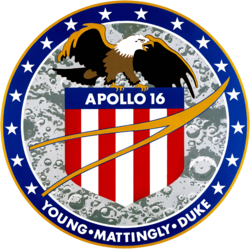Apollo 16
Apollo 16 was the tenth crewed space flight in NASA's Apollo program. It was the 5th of six Apollo missions to land on the Moon. It was a J-Type mission, which meant that the astronauts would have a longer stay on the Moon. Launched on April 16, 1972, Ken Mattingly stayed in orbit around the Moon in the Apollo Command Module, Casper. He spent 3 days, 9 hours and 28 minutes by himself, the longest solo US space flight.[1]: Script error: The function "hyphen2dash" does not exist.  On the Moon, astronauts John Young and Charles Duke got to put the Lunar Roving Vehicle ("moon buggy") through a series of tests, including s-turns, hairpin turns and quick stops.[2] John Young was the commander of the mission.
| Mission type | Crewed lunar landing |
|---|---|
| Operator | NASA |
| COSPAR ID | |
| Spacecraft properties | |
| Spacecraft | |
| Manufacturer |
|
| Crew | |
| Crew size | 3 |
| Members | |
| Orbital parameters | |
| Reference system | Selenocentric |

| |
A satellite was launched on the return journey to examine the Moon's mass and gravitation, space particles near the Moon, and the interaction of magnetic fields between the Moon and Earth.[2] The mission was stopped one day early as there were several problems with the spacecraft.[3]
Apollo 16 Media
Apollo 16 space-flown silver Robbins medallion
John Young and Charles Duke training at the Rio Grande Gorge in New Mexico
Young (right) and Duke training to drive the Lunar Roving Vehicle
Apollo 16's launch vehicle by the VAB, January 27, 1972
Apollo 16's Passive Seismic Experiment
Young driving the LRV during the "Grand Prix"
References
- ↑ Furniss, Tim (2001). The History of Space Vehicles. London: Grange Books. ISBN 1-84013-370-8.
- ↑ 2.0 2.1 "NASA - Apollo 16". nasa.gov. 2009. Retrieved August 11, 2012.
- ↑ "Astronaut Bio: Thomas K. Mattingly II". jsc.nasa.gov. 2010 [last update]. Retrieved August 12, 2012.









